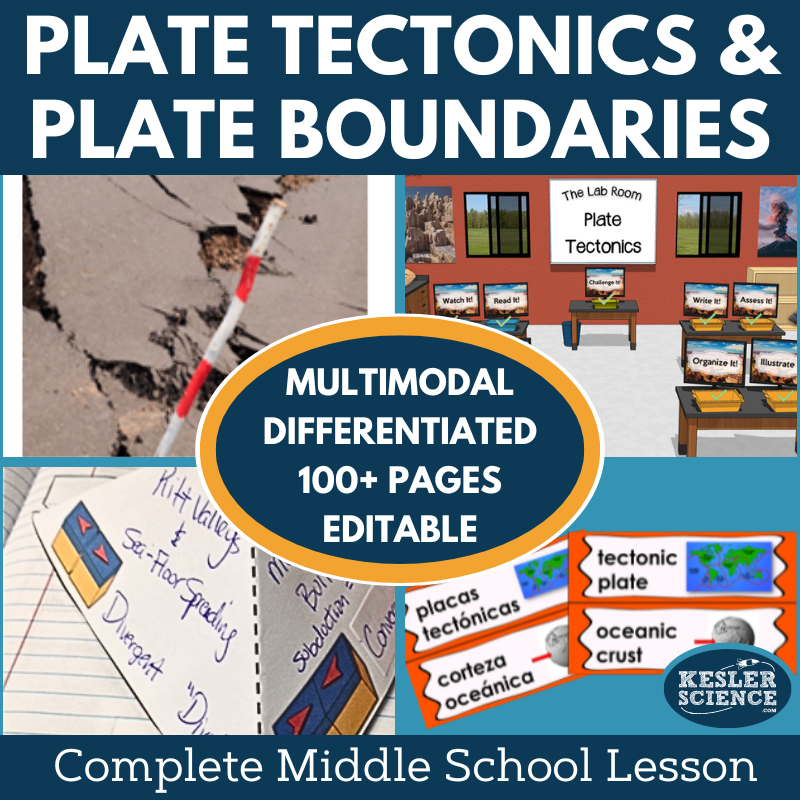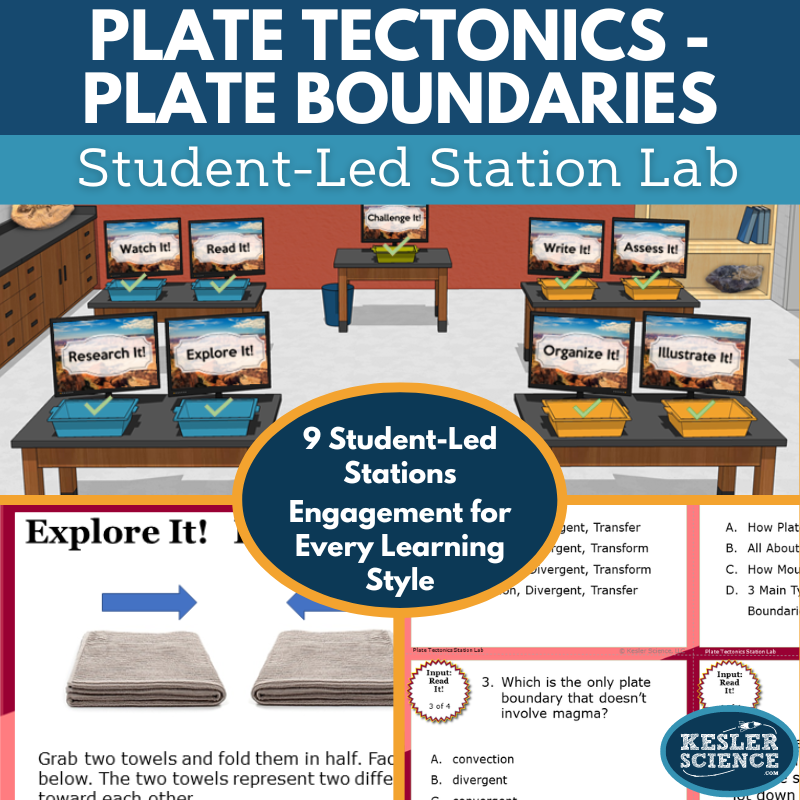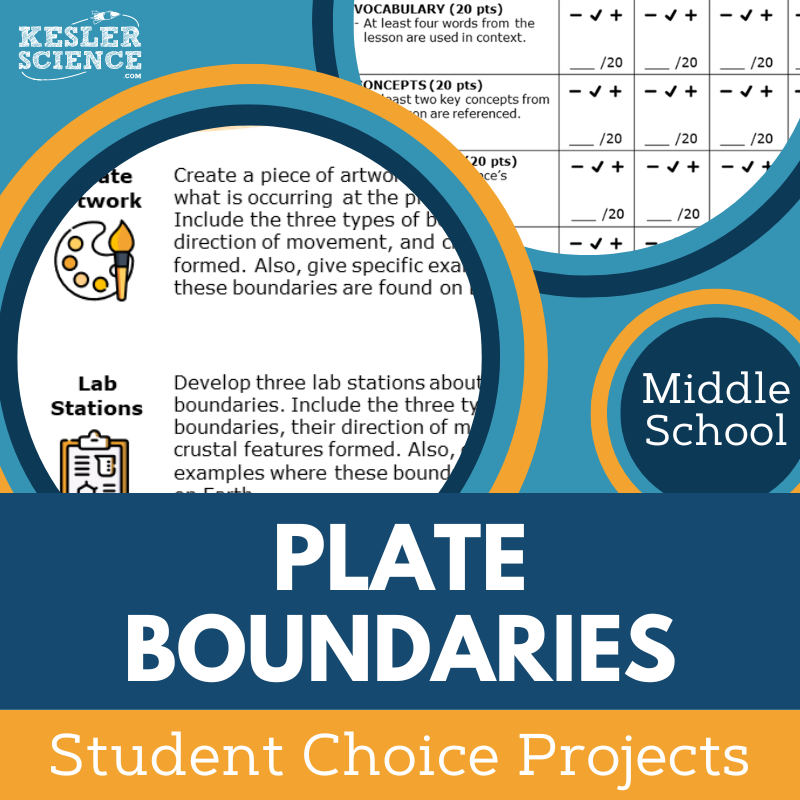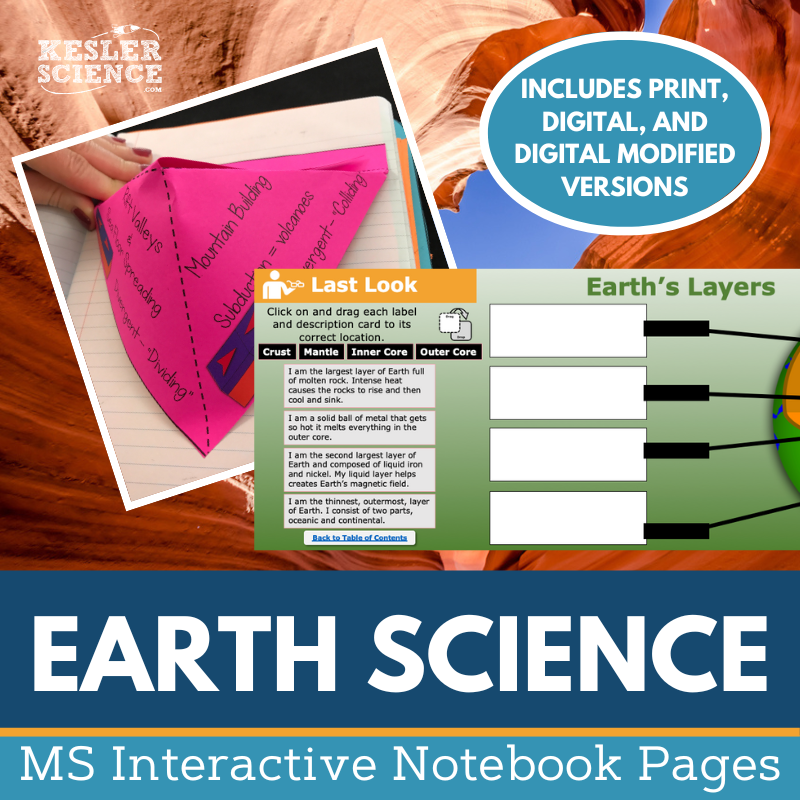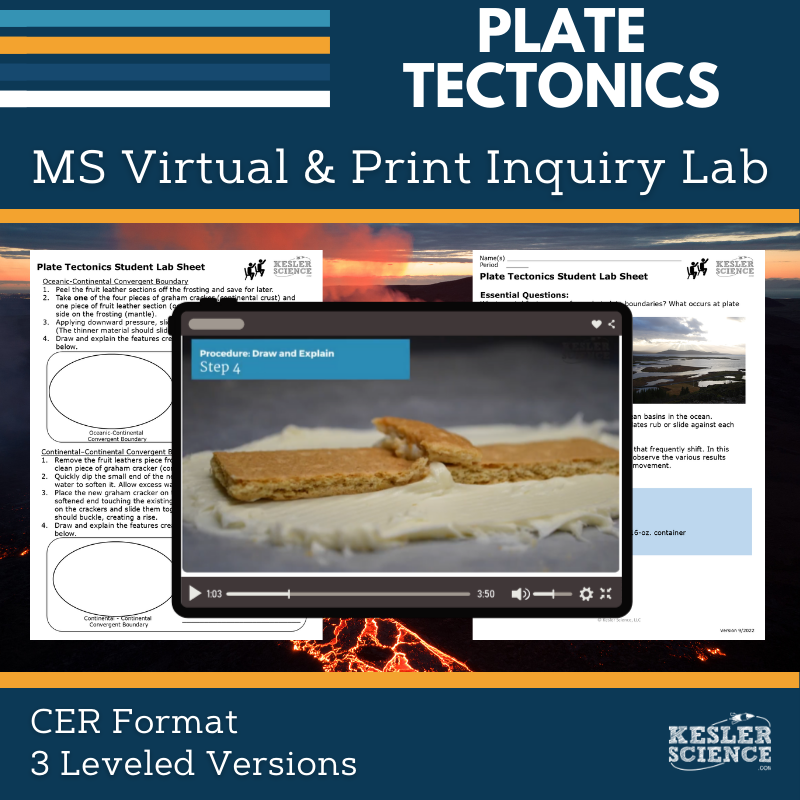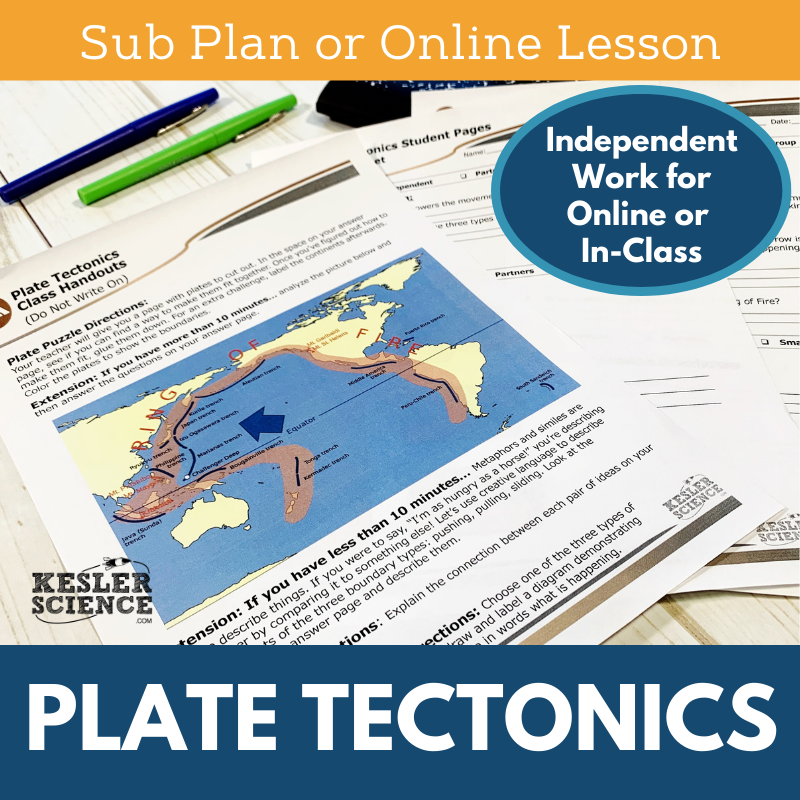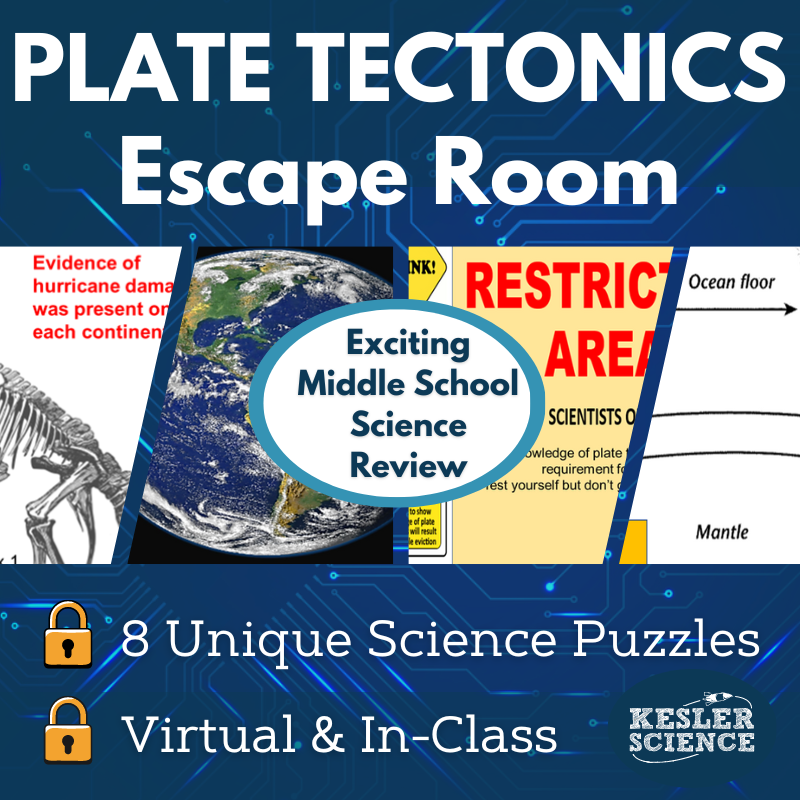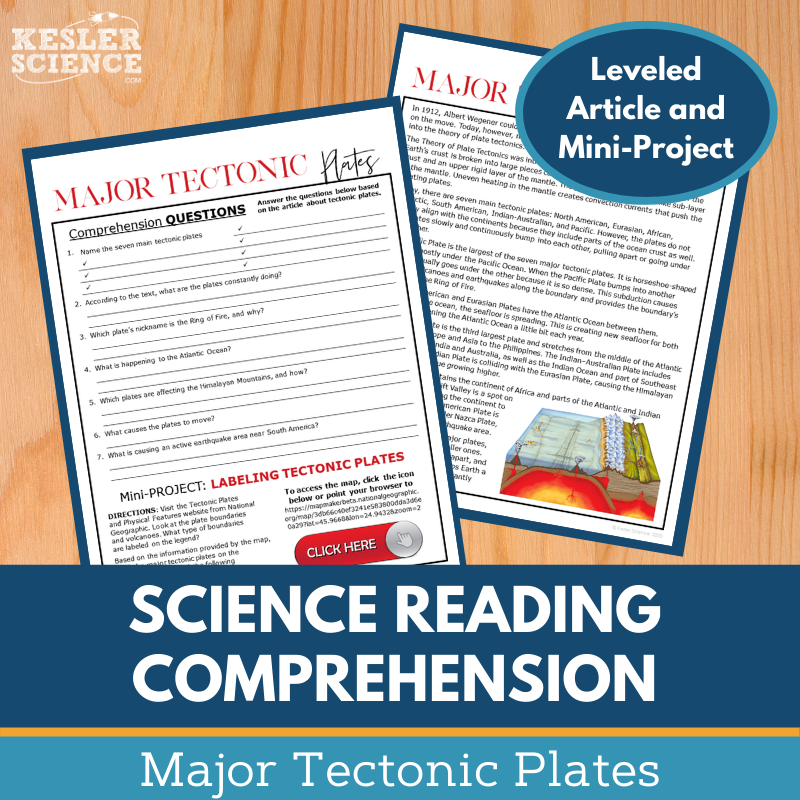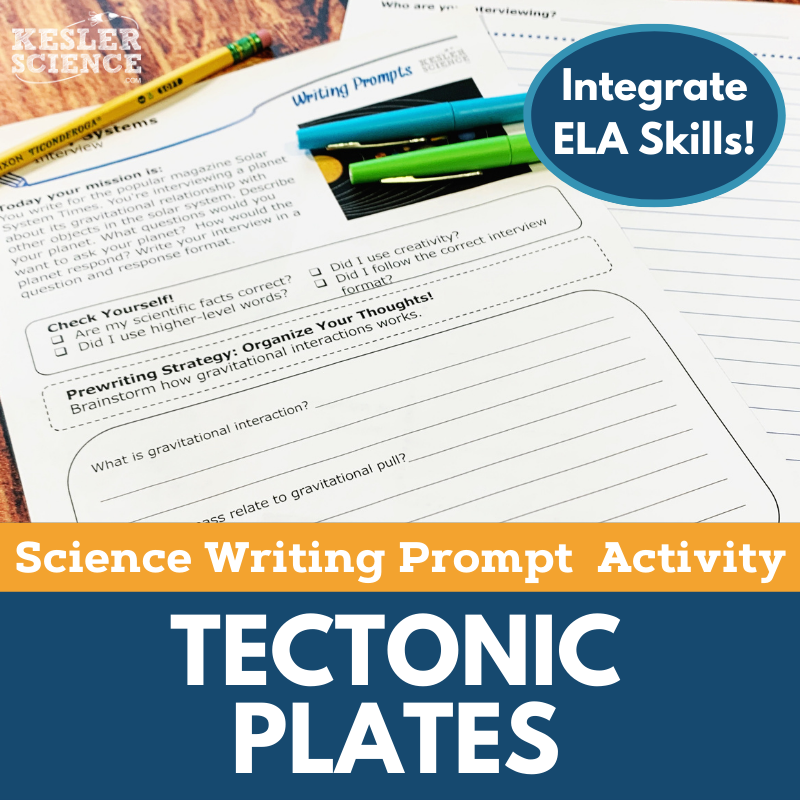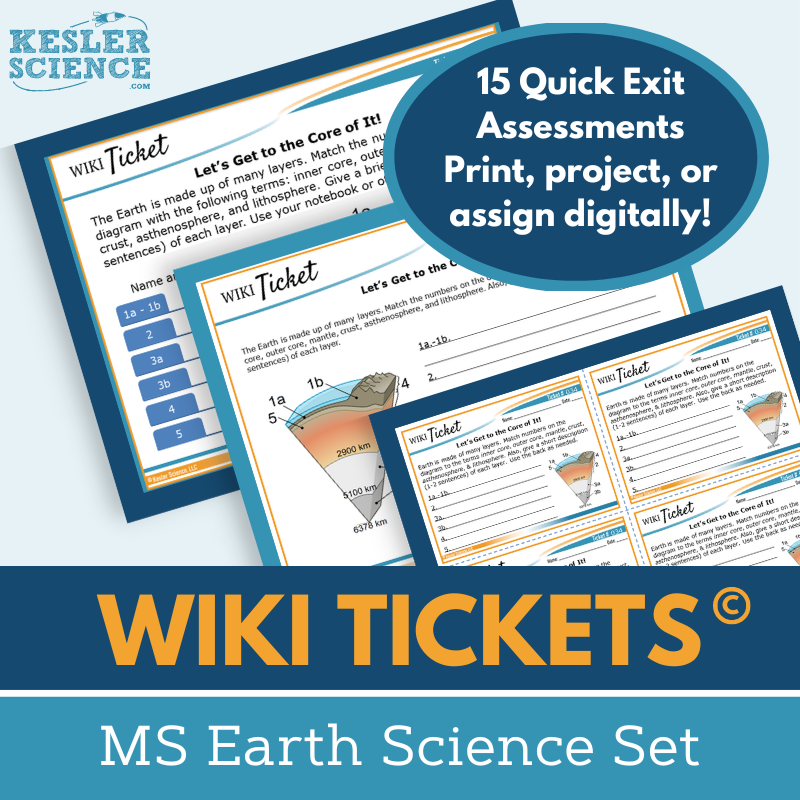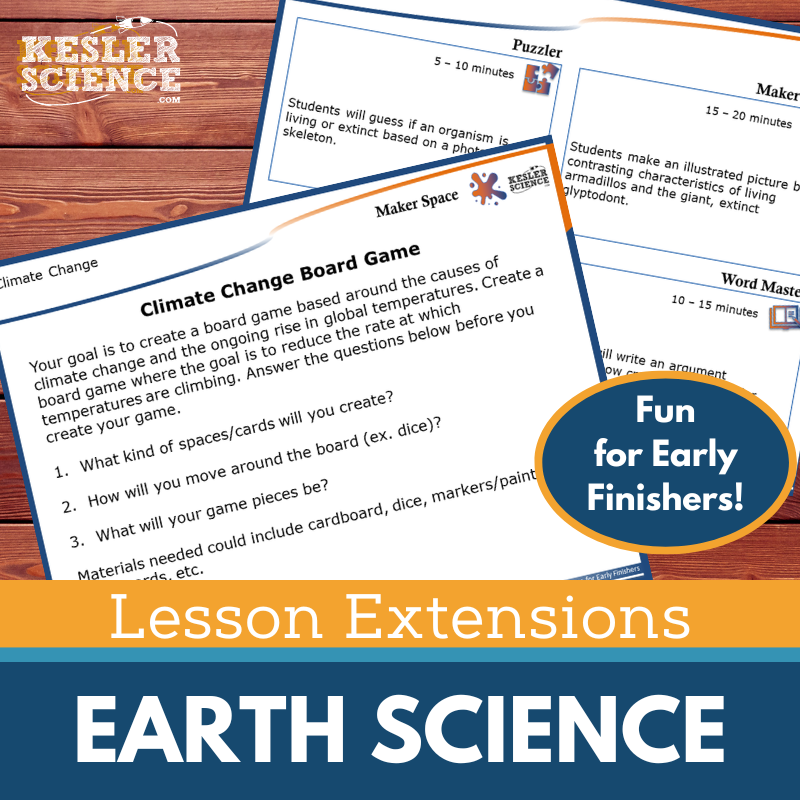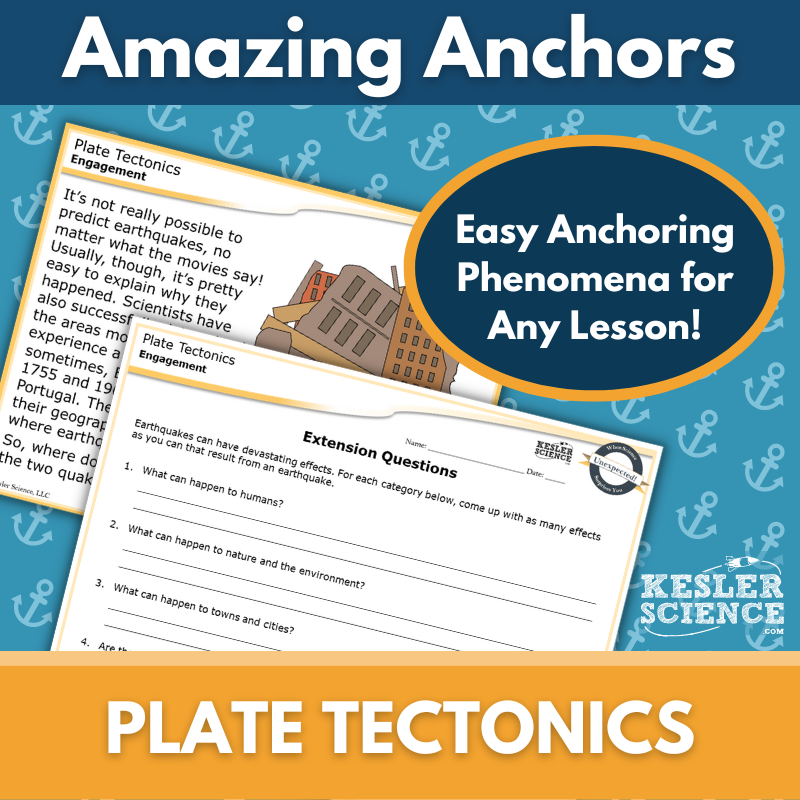Plate Boundaries Activities for Middle School Science
The Kesler Science Plate Boundaries resources offer a comprehensive, student-centered approach to understanding plate tectonics for middle school science classrooms. The resources below will give students a comprehensive understanding of plate boundaries. All of the following materials are also included in the Kesler Science Membership.
Make lesson planning a breeze with the Kesler Science Plate Tectonics Complete 5E Lesson for 6th to 8th grade. This ready-to-go resource offers differentiated materials, ensuring all students are engaged with minimal prep time for the teacher. It covers essential topics like plate tectonics, types of plate boundaries, and crustal features, all designed to promote student-led learning and foster success.
The lesson follows the 5E Model (Engagement, Exploration, Explanation, Elaboration, Evaluation) and includes activities like a student-led station lab with nine differentiated stations. From hands-on demonstrations and research tasks to interactive videos and reading comprehension, the stations allow students to explore plate tectonics in various ways. Additionally, output stations like “Organize It!” and “Write It!” give students multiple ways to showcase their understanding.
This lesson also includes editable PowerPoints, interactive notebook templates, Spanish translations, and flexible formats (printable or digital) for in-person and virtual learning. With standards-aligned assessments, review materials, and student-choice projects, it provides everything you need to effectively teach and evaluate students’ knowledge on plate tectonics.
Make lesson planning a breeze with the Kesler Science Plate Tectonics Complete 5E Lesson for 6th to 8th grade. This ready-to-go resource offers differentiated materials, ensuring all students are engaged with minimal prep time for the teacher. It covers essential topics like plate tectonics, types of plate boundaries, and crustal features, all designed to promote student-led learning and foster success.
The lesson follows the 5E Model (Engagement, Exploration, Explanation, Elaboration, Evaluation) and includes activities like a student-led station lab with nine differentiated stations. From hands-on demonstrations and research tasks to interactive videos and reading comprehension, the stations allow students to explore plate tectonics in various ways. Additionally, output stations like “Organize It!” and “Write It!” give students multiple ways to showcase their understanding.
This lesson also includes editable PowerPoints, interactive notebook templates, Spanish translations, and flexible formats (printable or digital) for in-person and virtual learning. With standards-aligned assessments, review materials, and student-choice projects, it provides everything you need to effectively teach and evaluate students’ knowledge on plate tectonics.
This Kesler Science modular, student-led Plate Tectonics Station Lab engages middle school students in learning about tectonic plates through a variety of differentiated activities. The student-centered approach allows learners to direct their own learning, with eight distinct stations covering multiple modalities, and a challenge station for advanced students. Teachers facilitate the experience, saving prep time while fostering independence.
The nine stations include hands-on demonstrations, research, reading, and videos that help students understand key concepts like plate boundaries and tectonic movements. Output stations, such as “Organize It!” and “Illustrate It!” give students the opportunity to apply and communicate their understanding. Additionally, “Write It!” and “Assess It!” stations provide structured ways to reflect and demonstrate mastery of the content.
This resource is designed for both in-class and virtual learning, with digital versions of tasks available for remote students.
This Kesler Science modular, student-led Plate Tectonics Station Lab engages middle school students in learning about tectonic plates through a variety of differentiated activities. The student-centered approach allows learners to direct their own learning, with eight distinct stations covering multiple modalities, and a challenge station for advanced students. Teachers facilitate the experience, saving prep time while fostering independence.
The nine stations include hands-on demonstrations, research, reading, and videos that help students understand key concepts like plate boundaries and tectonic movements. Output stations, such as “Organize It!” and “Illustrate It!” give students the opportunity to apply and communicate their understanding. Additionally, “Write It!” and “Assess It!” stations provide structured ways to reflect and demonstrate mastery of the content.
This resource is designed for both in-class and virtual learning, with digital versions of tasks available for remote students.
The Kesler Science Plate Boundaries Student Choice Projects offer middle school students a variety of project options to demonstrate their knowledge in a way that suits their learning style. With six different project options and a "design your own" project, students have the freedom to choose the best way to showcase their understanding of plate boundaries. The flexible grading rubric allows for assessments by teachers, peers, or students themselves.
The Student Choice Projects are dynamic and adaptable, with differentiated options to support a range of learning needs. Teachers can modify the rubric to align with their specific grading preferences, and multimodal project choices ensure students can creatively present their knowledge. Additionally, some project options are designed to assist students needing more support, while others provide challenges for advanced learners.
Included in the purchase are nine project choices plus a “design your own” option, teacher directions, and editable rubric pages that assess vocabulary, concepts, presentation, clarity, and accuracy. Supplies needed are minimal, with projects primarily requiring basic classroom materials such as paper, markers, and scissors, or digital tools for those who prefer a tech-based approach.
The Kesler Science Plate Boundaries Student Choice Projects offer middle school students a variety of project options to demonstrate their knowledge in a way that suits their learning style. With six different project options and a "design your own" project, students have the freedom to choose the best way to showcase their understanding of plate boundaries. The flexible grading rubric allows for assessments by teachers, peers, or students themselves.
The Student Choice Projects are dynamic and adaptable, with differentiated options to support a range of learning needs. Teachers can modify the rubric to align with their specific grading preferences, and multimodal project choices ensure students can creatively present their knowledge. Additionally, some project options are designed to assist students needing more support, while others provide challenges for advanced learners.
Included in the purchase are nine project choices plus a “design your own” option, teacher directions, and editable rubric pages that assess vocabulary, concepts, presentation, clarity, and accuracy. Supplies needed are minimal, with projects primarily requiring basic classroom materials such as paper, markers, and scissors, or digital tools for those who prefer a tech-based approach.
The Kesler Science Earth Science Interactive Notebook Bundle is a must-have for teachers who want to provide an interactive learning experience in earth science. It includes both print and digital versions, making it a versatile resource for traditional classrooms, 1:1 environments, and distance learning.
The bundle covers a wide range of earth science topics, including Continental Drift Theory, plate boundaries, rocks and minerals, the rock cycle, Earth’s layers, volcanoes, earthquakes, and more. It also features activities like Venn diagrams, topographic maps, and reflection pages to help students demonstrate understanding and make connections between concepts.
The digital version includes a unique interactive notebook PowerPoint, which can be uploaded to Google Slides or learning management systems like MS Teams and Canvas. The paper version provides blank and pre-filled templates, along with color photos to guide students in completing each activity. Both versions come with a teacher answer key and a modified version for students with accommodations.
The Kesler Science Earth Science Interactive Notebook Bundle is a must-have for teachers who want to provide an interactive learning experience in earth science. It includes both print and digital versions, making it a versatile resource for traditional classrooms, 1:1 environments, and distance learning.
The bundle covers a wide range of earth science topics, including Continental Drift Theory, plate boundaries, rocks and minerals, the rock cycle, Earth’s layers, volcanoes, earthquakes, and more. It also features activities like Venn diagrams, topographic maps, and reflection pages to help students demonstrate understanding and make connections between concepts.
The digital version includes a unique interactive notebook PowerPoint, which can be uploaded to Google Slides or learning management systems like MS Teams and Canvas. The paper version provides blank and pre-filled templates, along with color photos to guide students in completing each activity. Both versions come with a teacher answer key and a modified version for students with accommodations.
The Plate Tectonics Inquiry Lab aligns with NGSS standards by helping students explore how different movements at tectonic plate boundaries lead to the formation of various landforms. Students will create models of plate boundaries using simple materials like graham crackers and frosting, then observe the results of each type of interaction. Through guided questions, they will analyze how the location and type of boundary activity affect landform development.
This resource includes three differentiated versions—dependent, modified, and independent—to meet the needs of all learners. Each version supports students in developing scientific thinking through comprehension questions, Claim-Evidence-Reasoning (C.E.R.) prompts, and reflection activities. The print and digital formats offer maximum flexibility for in-person or remote learning, making it easy to adapt to classroom needs.
Teachers will find editable files, answer keys, and planning resources to simplify instruction and grading. The digital version requires no materials and includes interactive components compatible with Google Slides, while the print version offers a hands-on experience using everyday supplies. This lab provides a comprehensive, student-centered approach to investigating Earth’s dynamic surface.
The Plate Tectonics Inquiry Lab aligns with NGSS standards by helping students explore how different movements at tectonic plate boundaries lead to the formation of various landforms. Students will create models of plate boundaries using simple materials like graham crackers and frosting, then observe the results of each type of interaction. Through guided questions, they will analyze how the location and type of boundary activity affect landform development.
This resource includes three differentiated versions—dependent, modified, and independent—to meet the needs of all learners. Each version supports students in developing scientific thinking through comprehension questions, Claim-Evidence-Reasoning (C.E.R.) prompts, and reflection activities. The print and digital formats offer maximum flexibility for in-person or remote learning, making it easy to adapt to classroom needs.
Teachers will find editable files, answer keys, and planning resources to simplify instruction and grading. The digital version requires no materials and includes interactive components compatible with Google Slides, while the print version offers a hands-on experience using everyday supplies. This lab provides a comprehensive, student-centered approach to investigating Earth’s dynamic surface.
The Kesler Science Plate Tectonics Sub Plans guide students through a warm-up, reading passage, independent activity, extensions for early finishers, and an assessment. Students begin by completing a graphic organizer, then label diagrams of divergent, convergent, and transform plate boundaries while describing the processes at each boundary. For early finishers, extension activities include analyzing a world map or creating metaphors for plate boundaries.
The Plate Tectonics Sub Plans conclude with an assessment or exit ticket. Extensive instructions are provided for substitutes, and a distance learning version includes a Google Form answer sheet. These lessons are designed for both in-class and online learning, ensuring seamless transitions and effective coverage of content.
Each lesson includes engaging activities, substitute instructions, answer keys, student handouts, and editable documents.
The Kesler Science Plate Tectonics Sub Plans guide students through a warm-up, reading passage, independent activity, extensions for early finishers, and an assessment. Students begin by completing a graphic organizer, then label diagrams of divergent, convergent, and transform plate boundaries while describing the processes at each boundary. For early finishers, extension activities include analyzing a world map or creating metaphors for plate boundaries.
The Plate Tectonics Sub Plans conclude with an assessment or exit ticket. Extensive instructions are provided for substitutes, and a distance learning version includes a Google Form answer sheet. These lessons are designed for both in-class and online learning, ensuring seamless transitions and effective coverage of content.
Each lesson includes engaging activities, substitute instructions, answer keys, student handouts, and editable documents.
The Kesler Science Plate Tectonics Escape Room provides an engaging way for students to demonstrate their knowledge of plate tectonics and Wegener's continental drift theory. Teachers have full control over the activity, choosing from eight independent puzzles to fit different class periods. The escape room can be set up using simple materials like manila envelopes or with more authentic props, such as locks and storage boxes, to enhance the experience.
For digital use, a Single Student Digital Version can be assigned via Google Slides or email, allowing students to solve puzzles and manipulate images online. A printable version in PPT or PDF is also available for at-home use.
The Plate Tectonics Escape Room includes detailed teacher directions, answer keys, editable templates, and digital tools like Google Forms for assessments. Additional resources, such as a video challenge, printable props, reward templates, and photo props, make the escape room a memorable and exciting activity that students will love!
The Kesler Science Plate Tectonics Escape Room provides an engaging way for students to demonstrate their knowledge of plate tectonics and Wegener's continental drift theory. Teachers have full control over the activity, choosing from eight independent puzzles to fit different class periods. The escape room can be set up using simple materials like manila envelopes or with more authentic props, such as locks and storage boxes, to enhance the experience.
For digital use, a Single Student Digital Version can be assigned via Google Slides or email, allowing students to solve puzzles and manipulate images online. A printable version in PPT or PDF is also available for at-home use.
The Plate Tectonics Escape Room includes detailed teacher directions, answer keys, editable templates, and digital tools like Google Forms for assessments. Additional resources, such as a video challenge, printable props, reward templates, and photo props, make the escape room a memorable and exciting activity that students will love!
In this engaging lesson, students study the seven major tectonic plates by reading a nonfiction article that covers their locations and boundary types. After reading, students complete comprehension questions and label a map with tectonic plates and their boundaries. This lesson promotes science literacy and enhances reading comprehension through interactive activities.
Designed for grades 6-8 (and higher-level 5th graders), the leveled science reading passage is available at Lexile levels 1100-1300. It includes a mini-project that encourages hands-on learning and a Cornell notes template for note-taking. The engaging, colorful graphics are easy to print and can be adapted for virtual learning environments.
This resource is ideal for absent students, extra credit, sub plans, and whole-class instruction. It can be used in a variety of settings, including Google Classroom, MS Teams, and Canvas. Teachers can assign the passage throughout a unit to build science literacy or use it to foster meaningful classroom discussions and improve textual analysis skills.
In this engaging lesson, students study the seven major tectonic plates by reading a nonfiction article that covers their locations and boundary types. After reading, students complete comprehension questions and label a map with tectonic plates and their boundaries. This lesson promotes science literacy and enhances reading comprehension through interactive activities.
Designed for grades 6-8 (and higher-level 5th graders), the leveled science reading passage is available at Lexile levels 1100-1300. It includes a mini-project that encourages hands-on learning and a Cornell notes template for note-taking. The engaging, colorful graphics are easy to print and can be adapted for virtual learning environments.
This resource is ideal for absent students, extra credit, sub plans, and whole-class instruction. It can be used in a variety of settings, including Google Classroom, MS Teams, and Canvas. Teachers can assign the passage throughout a unit to build science literacy or use it to foster meaningful classroom discussions and improve textual analysis skills.
The Kesler Science Tectonic Plates Science Writing Prompt engages middle school students in exploring earth science through a creative travel brochure format. This low-prep, student-centered activity enhances science reasoning and writing while promoting hands-on learning. With the ability to be used in-class or for virtual learning, students will deepen their understanding of tectonic plates and their locations, including the Eurasian, African, Indo-Australian, Pacific, North American, and South American plates.
Standards-aligned, the activity provides students with an opportunity for creative exploration. It offers differentiated formats, such as full-sized and half-sheet handouts, and a digital version for Google Slides or PowerPoint. The included rubrics, teacher directions, and answer guides make it easy for educators to implement this engaging project across various settings, including for remote learners.
The project can be used for a variety of purposes, such as cross-curricular activities, differentiation, extra credit, or student choice projects. It's perfect for formative assessments, TELPAS samples, or as make-up work. The activity encourages students to apply their knowledge creatively and provides opportunities for review and reflection, making it a valuable addition to any science curriculum.
The Kesler Science Tectonic Plates Science Writing Prompt engages middle school students in exploring earth science through a creative travel brochure format. This low-prep, student-centered activity enhances science reasoning and writing while promoting hands-on learning. With the ability to be used in-class or for virtual learning, students will deepen their understanding of tectonic plates and their locations, including the Eurasian, African, Indo-Australian, Pacific, North American, and South American plates.
Standards-aligned, the activity provides students with an opportunity for creative exploration. It offers differentiated formats, such as full-sized and half-sheet handouts, and a digital version for Google Slides or PowerPoint. The included rubrics, teacher directions, and answer guides make it easy for educators to implement this engaging project across various settings, including for remote learners.
The project can be used for a variety of purposes, such as cross-curricular activities, differentiation, extra credit, or student choice projects. It's perfect for formative assessments, TELPAS samples, or as make-up work. The activity encourages students to apply their knowledge creatively and provides opportunities for review and reflection, making it a valuable addition to any science curriculum.
The Kesler Science Earth Science WIKI Tickets provide formative assessments for 6th-8th grade science topics, offering flexible options to check students' understanding in an engaging format. Each topic includes five versions: a full-screen projection version, three handout sizes (full, split, and quarter-page), and an interactive digital version for Google Slides or PowerPoint.
The Earth Science WIKI Tickets cover a wide range of earth science topics, including minerals, plate tectonics, the rock cycle, and human impact on the environment. Some topics have more than one ticket, but every topic is covered by at least one.
The WIKI Tickets can be used in both in-person and virtual learning environments. They work great as exit tickets, bellringers, or informal assessments during lessons. Teachers can project them, use printable handouts, or assign them digitally for remote students, making them adaptable for any teaching situation.
The Kesler Science Earth Science WIKI Tickets provide formative assessments for 6th-8th grade science topics, offering flexible options to check students' understanding in an engaging format. Each topic includes five versions: a full-screen projection version, three handout sizes (full, split, and quarter-page), and an interactive digital version for Google Slides or PowerPoint.
The Earth Science WIKI Tickets cover a wide range of earth science topics, including minerals, plate tectonics, the rock cycle, and human impact on the environment. Some topics have more than one ticket, but every topic is covered by at least one.
The WIKI Tickets can be used in both in-person and virtual learning environments. They work great as exit tickets, bellringers, or informal assessments during lessons. Teachers can project them, use printable handouts, or assign them digitally for remote students, making them adaptable for any teaching situation.
The Kesler Science Earth Science Lesson Extensions offer engaging activities for fast finishers, fostering critical thinking and creativity. These extensions are designed to scaffold learning for students ready to dive deeper into earth science topics while aligning with NGSS and TEKS standards. They provide a fun yet rigorous way to enhance lessons and keep students focused during independent work or testing.
Each Lesson Extension includes four core activities: a Puzzler to improve problem-solving, a Maker Space to promote STEAM connections, a Tech Connection to demonstrate learning through digital media, and a Word Master activity to integrate creative writing. These activities ensure students engage with the content in a variety of ways, helping reinforce their understanding.
The Lesson Extensions come with teacher directions, answer keys, and both paper and digital versions for flexibility. Perfect for wrapping up lessons or providing enrichment, these extensions cover a wide range of earth science topics like climate change, fossil fuels, and plate tectonics, all while meeting high-level science standards.
The Kesler Science Earth Science Lesson Extensions offer engaging activities for fast finishers, fostering critical thinking and creativity. These extensions are designed to scaffold learning for students ready to dive deeper into earth science topics while aligning with NGSS and TEKS standards. They provide a fun yet rigorous way to enhance lessons and keep students focused during independent work or testing.
Each Lesson Extension includes four core activities: a Puzzler to improve problem-solving, a Maker Space to promote STEAM connections, a Tech Connection to demonstrate learning through digital media, and a Word Master activity to integrate creative writing. These activities ensure students engage with the content in a variety of ways, helping reinforce their understanding.
The Lesson Extensions come with teacher directions, answer keys, and both paper and digital versions for flexibility. Perfect for wrapping up lessons or providing enrichment, these extensions cover a wide range of earth science topics like climate change, fossil fuels, and plate tectonics, all while meeting high-level science standards.
This Amazing Anchors Phenomenon Lesson introduces and reinforces plate tectonics through the real-world context of earthquakes. It begins with an engaging reading about earthquakes accompanied by comprehension and extension questions, followed by an explanatory passage that unpacks the science of plate tectonics and seismic activity in a student-friendly way. Together, these readings help anchor key science concepts before and after the main lesson.
Aligned with TEKS standards, this no-prep resource includes teacher directions, answer keys, editable materials, and versions suitable for projection, digital sharing, or student notebooks. The materials are available in both full- and half-sheet formats and are designed to support instruction in a variety of settings, including Google Classroom and other learning management systems.
Differentiated for diverse learners, the lesson includes a modified version that offers sentence starters and accessible language to help all students succeed with the comprehension questions. These bookend activities are ideal for the Engagement and Elaborate phases of the 5E instructional model, making them a valuable supplement to any plate tectonics lesson.
This Amazing Anchors Phenomenon Lesson introduces and reinforces plate tectonics through the real-world context of earthquakes. It begins with an engaging reading about earthquakes accompanied by comprehension and extension questions, followed by an explanatory passage that unpacks the science of plate tectonics and seismic activity in a student-friendly way. Together, these readings help anchor key science concepts before and after the main lesson.
Aligned with TEKS standards, this no-prep resource includes teacher directions, answer keys, editable materials, and versions suitable for projection, digital sharing, or student notebooks. The materials are available in both full- and half-sheet formats and are designed to support instruction in a variety of settings, including Google Classroom and other learning management systems.
Differentiated for diverse learners, the lesson includes a modified version that offers sentence starters and accessible language to help all students succeed with the comprehension questions. These bookend activities are ideal for the Engagement and Elaborate phases of the 5E instructional model, making them a valuable supplement to any plate tectonics lesson.
Year-Round Resources
These year-round activities will increase your students' understanding of many middle school science topics. All of these activities are also included in the Kesler Science Membership.
Visual Data & Graphing
You're not alone if your students struggle with understanding graphs, charts, and tables. It's a skill that takes an enormous amount of practice. This resource will help students build a strong foundation in analyzing data and creating their own data visualizations.
Bell Ringers and Warm-Ups
These middle school science bell ringers are an excellent way to engage your students as soon as they walk into your classroom. This comprehensive FULL YEAR resource includes everything you need to start off each science class with an interesting warm-up activity.
Review Board Games
Each game board has been carefully designed to keep students engaged. There are 10 different action spaces on each board and dozens of question cards. All of the actions are related to science concepts and keep the students motivated throughout the game.
Each game is ready to play. Simply print out the board and the cards and let the students enjoy reviewing nine different units.
Essential Questions
Below are the essential questions associated with the lessons and activities included in this unit. This topic is only one of more than 100 middle school science topics included in the Kesler Science Membership.
-
What is plate tectonics?
-
What are the three types of plate boundaries?
-
What crustal features are formed at plate boundaries?
Kesler Science Membership
Imagine never having to search for another middle school science lesson again. The membership gives you access to ALL of the Kesler Science products in one place (Yes, including everything above).
Say goodbye to long hours of lesson prep.

